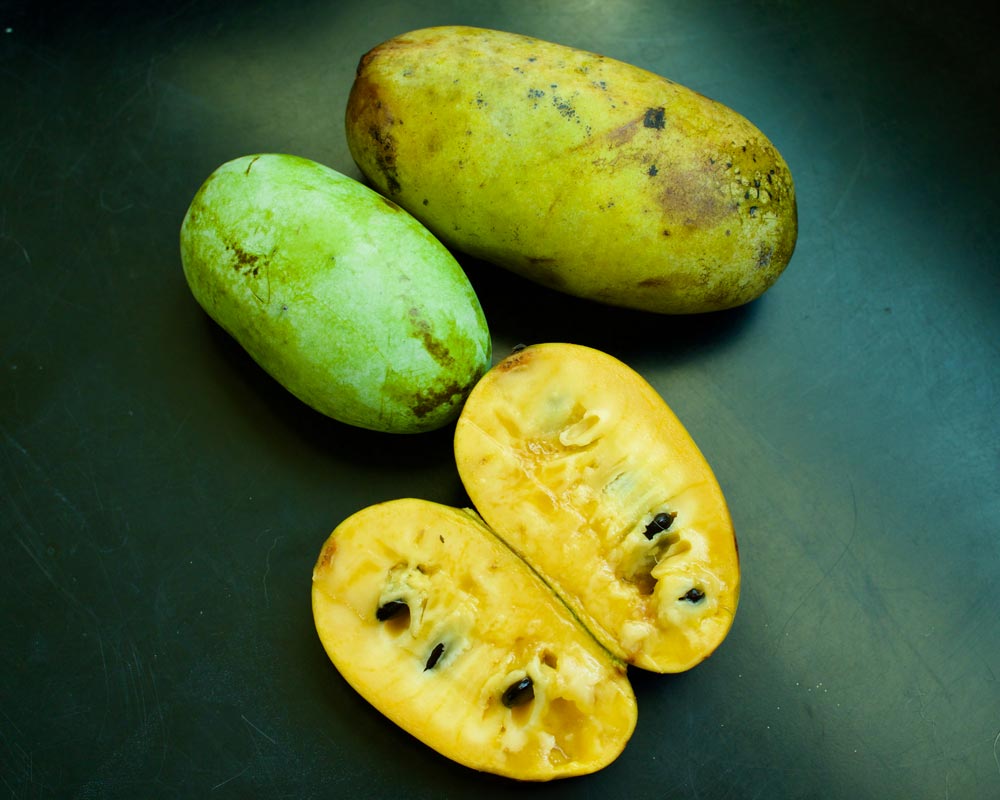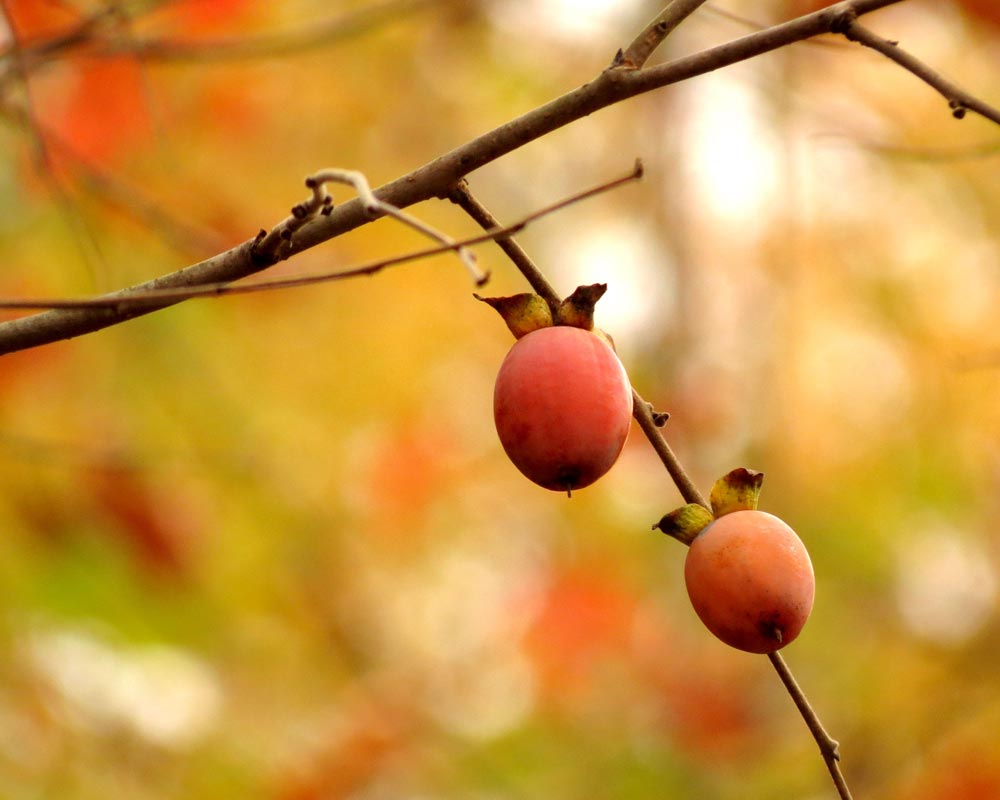The Mid-Atlantic region of the United States boasts a rich tapestry of flora, much of which has sustained indigenous peoples and settlers for centuries. Beyond their aesthetic appeal, many of these plants offer nutritional value and culinary wealth. In this exploration, we’ll delve into some of the edible plants native to this diverse and ecologically vibrant area and appropriate for home gardens.
Pawpaw (Asimina triloba): Let’s start with a hidden gem of the Mid-Atlantic forests – the pawpaw tree. Often referred to as “America’s forgotten fruit,” the pawpaw tree produces deliciously sweet and custardy fruits that are perfect for smoothies, pudding, jams, and enjoying fresh off the tree. They are most often harvested when ripe. Ripe pawpaws typically turn from bright green to a slightly yellowish hue, with the surface yielding slightly to gentle pressure.
These trees thrive in the region’s rich, well-drained soils and dappled shade, making them a fantastic addition to any garden seeking a touch of tropical flair. Pawpaw trees are self-incompatible, usually requiring pollen from a genetically different tree to be fertilized. We find planting three different varieties creates a small grove suitable for the home garden. Remember, different varieties produce various sizes of fruit from the size of a large mango to a small fruit that fits in the palm of a child’s hand.
American Persimmon (Diospyros virginiana): Next up, we have the American persimmon, a small deciduous tree that boasts vibrant orange fruits with a uniquely sweet and tangy flavor. Native to woodlands and stream banks, these trees are remarkably resilient and can tolerate a wide range of soil conditions. Just be sure to wait until the fruits are fully ripe – soft and jelly-like – before indulging in their deliciousness!
Eastern Redbud (Cercis canadensis): While not traditionally grown for its fruit, the Eastern redbud tree offers a surprising culinary delight – its vibrant pink flowers! These blossoms add a pop of color to salads, desserts, and even savory dishes, infusing them with a subtle floral flavor reminiscent of springtime. Plus, as a native understory tree, the Eastern Redbud thrives in the dappled shade of larger trees, making it a perfect choice for gardens with limited sunlight. There are many Redbud cultivars available on the market and we are not sure of their taste, though the species Cercis canadensis is adorned with a plethora of seed pods that love to germinate wherever they land.
Wild Bergamot (Monarda fistulosa): an edible native Mid-Atlantic herb garden would be complete without a patch of wild bergamot, also known as bee balm. This aromatic perennial herb produces clusters of lavender-pink flowers that not only attract pollinators but also make a delicious and soothing tea. Simply steep the dried leaves and flowers in hot water for a fragrant brew that’s perfect for sipping on a lazy afternoon. Please find more native garden herbs here!
Ramps (Allium tricoccum): Last but certainly not least, we have ramps – the darling of foragers and foodies alike. These wild leeks boast a pungent flavor that’s a cross between garlic and onion, making them a versatile addition to soups, salads, and sautés. While they’re typically found in shady, wooded areas, ramps can also thrive in a garden setting with well-drained soil and a bit of dappled sunlight.
Jerusalem Artichoke (Helianthus tuberosus): Also known as sunchoke, Jerusalem artichoke is a sunflower species prized for its edible tubers. Native to North America, these knobby, root vegetables have a sweet, nutty flavor reminiscent of water chestnuts. They can be enjoyed raw in salads, roasted, mashed, or made into soups and purees.
Chokeberries: Also known as aronia berries, come in two main varieties: black chokeberries (Aronia melanocarpa) and red chokeberries (Aronia arbutifolia). Despite their somewhat intimidating name, chokeberries are anything but bland – they boast a rich, tart flavor that’s reminiscent of sour cherries or cranberries, with a hint of sweetness lurking beneath their deep purple or red-black skin.
Highbush Blueberries (Vaccinium corymbosum): When it comes to blueberries, there’s a delightful array of varieties to choose from, each with its own unique flavor profile and growing habits. Blueberries are an acid-loving plant with all season interest – Spring flowers, summer fruit, red autumn foliage and some boast red winter stems. For the Mid-Atlantic region, look for Highbush cultivars that are well-suited to the local climate (Zone 4-7/8) and soil conditions, such as ‘Bluecrop’, ‘Duke’ ‘Bluegold’, ’Toro’. These varieties offer a balance of sweet and tart flavors and are known for their adaptability to the region’s fluctuating weather patterns.
Native Strawberries (Fragaria virginiana): Native strawberries, such as the Virginia strawberry, are perfectly adapted to the climate and soil conditions of the Mid-Atlantic region. These varieties offer a burst of flavor that’s unmatched by their commercial counterparts, with a perfect balance of sweetness and tartness that will tantalize your taste buds. By growing native strawberries, you’re not only enjoying superior flavor but also preserving the genetic diversity of these beloved fruits. When choosing native strawberry cultivars for your garden, look for varieties that are well-suited to the Mid-Atlantic climate and soil. Some popular options include ‘Hula’, ‘Sparkle’, and ‘Wild Treasure’, each with its own unique flavor profile and growing habits. These varieties are known for their disease resistance, productivity, and exceptional taste, making them ideal choices for home gardeners. Please keep in mind that strawberries can be an aggressive ground cover and are excellent container plants or grown in a sunny location on the outskirts of your gardens.



